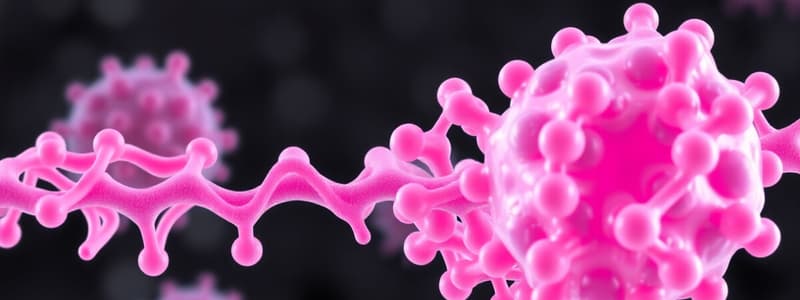Podcast
Questions and Answers
What is the primary role of Apo E in lipoprotein metabolism?
What is the primary role of Apo E in lipoprotein metabolism?
- To activate lipoprotein lipase
- To inhibit cholesterol transfer
- To transport dietary lipids
- To facilitate the uptake of remnant lipoproteins (correct)
Which apolipoprotein is associated with lecithin: cholesterol acyltransferase (LCAT)?
Which apolipoprotein is associated with lecithin: cholesterol acyltransferase (LCAT)?
- Apo A-I (correct)
- Apo B-48
- Apo C-III
- Apo C-I
What is the primary structural lipid component of chylomicrons?
What is the primary structural lipid component of chylomicrons?
- Cholesterol
- Phospholipids
- Triacylglycerol (correct)
- Free fatty acids
How long is the half-life of very low-density lipoproteins (VLDL)?
How long is the half-life of very low-density lipoproteins (VLDL)?
After the action of lipoprotein lipase, what primarily characterizes intermediate density lipoproteins (IDL)?
After the action of lipoprotein lipase, what primarily characterizes intermediate density lipoproteins (IDL)?
What is the primary lipid in chylomicrons and very low-density lipoproteins (VLDL)?
What is the primary lipid in chylomicrons and very low-density lipoproteins (VLDL)?
Which apolipoprotein is specifically found only in chylomicrons?
Which apolipoprotein is specifically found only in chylomicrons?
What is the function of apolipoproteins in lipoproteins?
What is the function of apolipoproteins in lipoproteins?
How does the density of lipoproteins change as the protein content increases?
How does the density of lipoproteins change as the protein content increases?
Which method is NOT used to separate lipoproteins?
Which method is NOT used to separate lipoproteins?
What component does lipoprotein (a) [Lpa] have in common with low-density lipoprotein (LDL)?
What component does lipoprotein (a) [Lpa] have in common with low-density lipoprotein (LDL)?
Which lipoprotein has the highest percentage of protein content?
Which lipoprotein has the highest percentage of protein content?
Which of the following is NOT a type of lipoprotein classified based on density?
Which of the following is NOT a type of lipoprotein classified based on density?
Flashcards
Chylomicron
Chylomicron
A lipoprotein that transports dietary lipids (mainly triacylglycerol) from the intestines to the peripheral tissues.
Apolipoprotein (Apo)
Apolipoprotein (Apo)
A protein attached to a lipoprotein that helps it interact with receptors in tissues.
Lipoprotein Lipase (LpL)
Lipoprotein Lipase (LpL)
An enzyme that breaks down triacylglycerol in chylomicrons and VLDL, releasing fatty acids for energy.
VLDL Remnant Formation
VLDL Remnant Formation
Signup and view all the flashcards
Intermediate Density Lipoprotein (IDL)
Intermediate Density Lipoprotein (IDL)
Signup and view all the flashcards
What are lipoproteins?
What are lipoproteins?
Signup and view all the flashcards
What are apolipoproteins?
What are apolipoproteins?
Signup and view all the flashcards
What is total plasma lipid?
What is total plasma lipid?
Signup and view all the flashcards
What is the surface layer of a lipoprotein?
What is the surface layer of a lipoprotein?
Signup and view all the flashcards
What is the core of a lipoprotein?
What is the core of a lipoprotein?
Signup and view all the flashcards
What are the main classes of apolipoproteins?
What are the main classes of apolipoproteins?
Signup and view all the flashcards
What is apo B100?
What is apo B100?
Signup and view all the flashcards
What is apo B48?
What is apo B48?
Signup and view all the flashcards
Study Notes
Lipid Transport Overview
- Lipids are insoluble in water.
- Lipids are associated with proteins to form lipoproteins, which are water-soluble.
- The protein part of lipoproteins is called apolipoprotein.
- Lipoproteins transport lipids between various tissues.
- Total plasma lipid is approximately 400-600 mg/dL and includes triacylglycerol (20%), phospholipids (30%), cholesterol (40%), and unesterified free fatty acids.
Lipoprotein Structure
- Lipoproteins consist of a lipid core (primarily triacylglycerol and cholesterol esters) surrounded by a shell of phospholipids, cholesterol, and apolipoproteins.
- Apolipoproteins are proteins associated with lipoproteins.
- Apolipoproteins vary in amount, some are peripheral and some are integral.
- Apolipoproteins range from 1% in chylomicrons to 60% in some HDLs.
Lipoprotein Classification
- Lipoprotein density increases with protein content.
- Lipoproteins are separated by ultracentrifugation and electrophoresis.
- Types include chylomicrons, VLDL, IDL, LDL, and HDL.
- Lipoprotein (a) has a similar lipid composition to LDL but also contains a unique protein component.
Apolipoproteins
- Apolipoproteins are synthesized primarily in the liver and small intestine.
- Major classes are A to E are known.
- Apo B exists in two forms: Apo B-100 and Apo B-48. Apo B-100 is component of LDL, whereas Apo B-48 is part of chylomicrons.
- Apo (a) is present in Lp(a) with Apo B-100. It has a high carbohydrate content.
- Apolipoproteins promote lipid solubility and stability.
- Apolipoproteins act as ligands for lipoprotein receptors, regulating tissue uptake.
- Examples of apolipoproteins include Apo B-100/E for LDL receptor, Apo E for remnant receptor, and ApoA-I for HDL receptor.
Apolipoprotein Functions
- Some apolipoproteins act as enzyme activators (e.g., C-II for lipoprotein lipase, A-I for lecithin:cholesterol acyltransferase[LCAT]).
- Some apolipoproteins act as enzyme inhibitors (e.g., ApoA-II and apoC-III for lipoprotein lipase).
Metabolism of Chylomicrons
- Site of synthesis: intestinal mucosa.
- Function: Transport dietary lipids from the intestine to peripheral tissues.
- Structure: lipids (mostly triacylglycerol), proteins (including Apo B-48, E, C-II).
- Half-life: approximately 1 hour.
Metabolism of VLDL
- Site of synthesis: liver.
- Function: Transport endogenously synthesized lipids from the liver to peripheral tissues.
- Structure: lipids (primarily triacylglycerol), proteins (including Apo B-100, E, C-II).
- Half-life: 1-3 hours.
Formation of IDL
- The action of lipoprotein lipase (LpL) reduces TAG and Apo C content in VLDL.
- This forms VLDL remnants, also known as IDL.
- IDL contains less TAG and more cholesterol.
- IDL is either taken up by the liver via LDL receptors or converted to LDL.
Studying That Suits You
Use AI to generate personalized quizzes and flashcards to suit your learning preferences.



